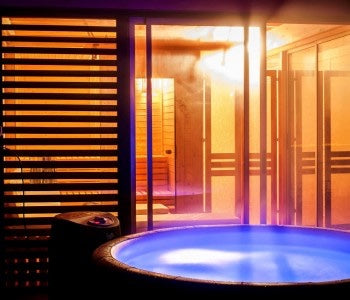Sweaty in a sauna or steamy in the bath— which is better for your body and brain?
Short answer: Infrared saunas (like your home sauna, garden sauna, or outdoor sauna) are great for detox, while hot baths calm you fast. Keep reading to find your perfect soak or sweat!

Understanding Infrared Saunas
What is an Infrared Sauna?
An infrared sauna uses infrared light to heat the body directly. Unlike traditional saunas, it doesn’t heat the air around you but instead warms your skin and core using infrared wavelengths.
It’s available in various styles—home sauna, garden sauna, and outdoor sauna options are increasingly popular across the UK for those seeking convenience and wellness from home.
How Infrared Saunas Work
Infrared saunas emit light in the near, mid, or far spectrum. This light penetrates the skin, raising your core temperature and stimulating sweating at lower ambient temperatures compared to traditional steam saunas.
Sessions typically last between 15–45 minutes and can be easily adjusted depending on tolerance and goals.
Key Benefits of Infrared Saunas
Increased Core Body Temperature and Deeper Sweat
Infrared saunas raise your body temperature from within. This leads to a more intense sweat at lower external temperatures, supporting better circulation and physical stress release.
Detoxification and Toxin Release
Sweating in an infrared sauna helps eliminate heavy metals, chemicals, and environmental toxins from the body. It's often promoted as a natural detox method that goes beyond skin-deep cleansing.
Improved Blood Circulation and Cardiovascular Health
The gentle heat causes blood vessels to dilate, improving blood flow and oxygen delivery. This can help with circulation, promote heart health, and even lower blood pressure over time.
Muscle Recovery and Pain Relief
Infrared heat penetrates deeply into muscles and joints. Many athletes and individuals with chronic pain use infrared sauna therapy to reduce soreness, stiffness, and recovery time.
Skin Health and Rejuvenation
The increased blood flow and sweating can boost skin tone and clarity. It may support collagen production, reduce signs of ageing, and help with acne-prone skin.
Stress Reduction and Relaxation
Infrared saunas provide a calming space to unwind. The warmth soothes the nervous system, helping reduce cortisol levels and ease mental fatigue.
Understanding Hot Baths
What is a Hot Bath?
A hot bath is a warm soak that uses heated water—typically between 37°C to 40°C. It’s one of the most accessible and widely used forms of hydrotherapy.
You don’t need fancy equipment. A bathtub and warm water are all it takes to create a relaxing experience.
How Hot Baths Work (Hydrotherapy)
Hot baths use water’s natural buoyancy, pressure, and warmth to relieve tension in muscles and joints. The heat helps blood vessels expand, reducing stiffness and encouraging healing.
Hydrotherapy has been used for centuries for physical and mental well-being.
Key Benefits of Hot Baths

Muscle Relaxation and Soothing Soreness
Hot water relaxes tight muscles and eases aches after a long day or intense workout. It also promotes blood flow to tired areas, supporting faster recovery.
Joint Pain Relief (Buoyancy Effect)
Floating in water takes pressure off the joints. This can reduce pain for people with arthritis or mobility issues, making daily movement easier and more comfortable.
Stress Reduction and Mental Calmness
The comforting warmth of a hot bath can lower stress hormones and activate the parasympathetic nervous system. A soak at the end of the day often leaves you calmer and more centred.
Improved Sleep Quality
Soaking before bed can support better sleep. As your body cools down after a bath, it signals the brain that it’s time to rest—making it easier to fall and stay asleep.
Enhanced Blood Flow and Circulation
Like the infrared sauna, warm baths also improve blood circulation. This helps oxygen and nutrients travel through the body, encouraging healing and energy restoration.
Infrared Sauna vs. Hot Bath: A Detailed Comparison
Key Differences in Experience and Functionality
Heating Method and Temperature
Infrared saunas heat the body using light and energy, while hot baths use warm water immersion. Infrared saunas usually operate at lower temperatures but provide a more intense internal heat.
Environment (Dry Heat vs. Water Immersion)
Infrared saunas offer dry heat, making it easier to breathe. Hot baths immerse you in water, which some find more soothing but may not suit everyone (especially if sensitive to humidity).
Installation, Space, and Maintenance
Infrared saunas—especially home, garden, and outdoor models—require initial setup and space but are relatively low maintenance. Baths are already part of most homes and require minimal effort.
Cost Considerations (Initial and Running)
Hot baths are more affordable and accessible. Infrared saunas have higher upfront costs, but they offer ongoing health perks with minimal energy use.
Comparing Health Benefits and Use Cases
For Post-Workout Muscle Recovery
Infrared sauna sessions penetrate deeply to relieve soreness and inflammation. Hot baths also help but may not reach muscle fibres as effectively.
For Improving Sleep
Both work well. Hot baths support sleep through thermoregulation, while infrared saunas reduce stress and balance cortisol, indirectly improving sleep.
For Detoxification and Immune Support
Infrared sauna therapy shines here. It promotes deep sweating and may support immune function through heat shock proteins and lymphatic stimulation.
For Cardiovascular Health and Blood Pressure
Infrared saunas improve circulation and can mimic cardiovascular exercise. Hot baths offer benefits too, but infrared sessions may provide a more consistent effect.
For Stress and Anxiety Reduction
Both options are excellent for mental health. Choose infrared saunas for meditative warmth and hot baths for comforting immersion.
Takeaways
-
Infrared saunas are ideal for deep detox, joint pain relief, and cardiovascular support.
-
Hot baths are perfect for quick stress relief, muscle relaxation, and better sleep.
-
Your choice depends on personal goals, space, and budget.
Conclusion
Whether you choose a hot bath for a soothing soak or an infrared sauna for a deeper detox, both options support your health and well-being. From home sauna to garden sauna, there’s something for everyone.
So go on—pick your steam, your style, and start sweating or soaking your way to better health.






